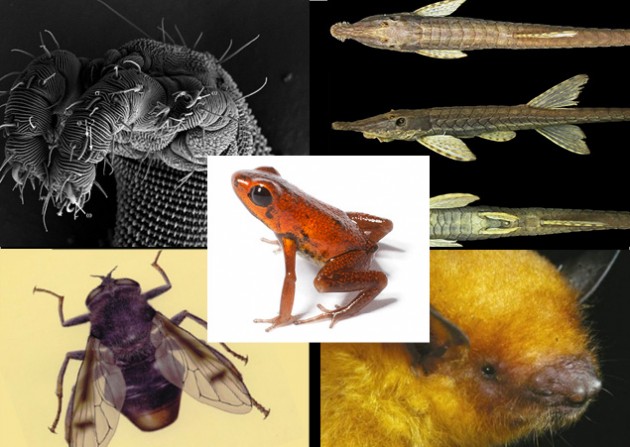
While it seems that we can find just about anything on the Internet, it doesn’t mean we know everything yet. Every year, Smithsonian scientists discover many new species around the globe and even in their own backyards.
Let’s take a look at some of this year’s interesting newcomers from the animal kingdom, found by our very own Smithsonian scientists. Scroll through to meet them.
1. Poison dart frog from Panama
If you had the chance to name a poisonous species, would you name it after your wife? That’s what Smithsonian Tropical Research Institute researcher Marcos Ponce did when he and his team discovered a bright orange poison dart frog in Donoso, Panama. His wife, Geminis Vargas, was the inspiration for the new species, Andinobates geminisae, “for her unconditional support of his studies of Panamanian herpetology.” Read more…

Andinobates geminisae (Photo: Brian Gratwicke)
2. Dragon-like mite
This new species has a face only a mother could love. But when you aren’t looking for a mate it doesn’t matter if you are attractive. Osperalycus tenerphagus, less than a millimeter long, has evolved an all-female lineage. No males and no mating. They lay eggs that don’t need to be fertilized, making little clones of themselves. The species was discovered in Ohio by Samuel Bolton, an entomologist and fellow at the Smithsonian’s National Museum of Natural History and researcher at Ohio State. Read more…

The front end of Osperalycus tenerphagus showing three of its legs and the unusual structure of its skin. (Photo courtesy Samuel Bolton)
3. Bolivia’s golden bat
Whether or not you like bats,, you can’t deny this new species is golden. Myotis midastactus, is just one of more than six species described by Ricardo Moratelli, a scientist at the Oswaldo Cruz Foundation (Brazil) and post-doctoral fellow at Smithsonian’s National Museum of Natural History. Read more…

Adult female of “Myotis midastactus” captured at Noel Kempff Mercado National Park, Department of Santa Cruz, Bolivia. Ricardo Moratelli and Don Wilson, mammalogist at the Smithsonian’s National Museum of Natural History recently named this bat as a new species. (Photo courtesy Marco Tschapka)
4. Armored catfish from Colombia
Farlowella yarigui is a new species of stick catfish from South America, so called because the thin, elongated bodies of these fish mimic sticks. About 5 inches long, it lives on the bottom of clear-running streams among partially submerged vegetation and sticks. This discovery by Gustavo Ballen from the Smithsonian Tropical Research Institute represents the first and only species of its genus found living in the Magdalena River basin, west of the Andes Mountains in South America. Read more…

“F. yarigui” belongs to a subfamily of armored catfish and is covered in bony plates that protect it from predators, such as birds and predator fishes.
5. Poppy pollinating fly
The new fly, named Sericomyia khamensis, mimics the bumble bee to fool predators into leaving it alone. Found in the highlands of southern China by Christian Thompson, an entomologist at the Smithsonian’s National Museum of Natural History, these flies are pollinators of the yellow poppy (Meconopsis integrifolia). Like bees, the female flies visit yellow poppies to drink nectar, but unlike their fellow pollinators they also eat the poppy pollen on the spot. Read more…

“Sericomyia khamensis,” a newly discovered flower fly from China





